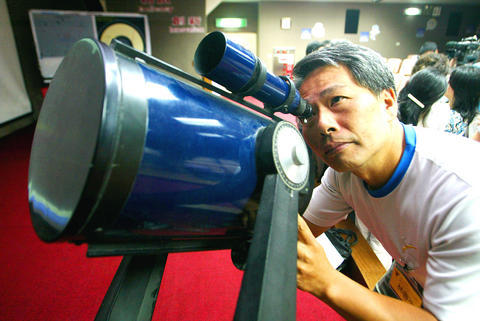It was so faint amid the star-freckled blackness that professional star-gazer Lin Chi-sheng (林啟生) missed it as he photographed the heavens from Lulin Observatory, Nantou County, earlier this month.
Luckily, Lin's camera, recording time-lapse images of space through the observatory's telescope, didn't miss it -- a mighty chunk of ice and rock "a few kilometers" in diameter and hurtling toward Earth: "Asteroid C/2007-N3."
Since named "Lulin Comet," the galactic "dirty snowball" -- as an observatory press release calls it -- won't mean much to the average terrestrial, except perhaps on Feb. 27, 2009, when the comet will likely become visible to the naked eye as it cruises within 60 million kilometers of Earth -- a "close shave" in astronomical terms.

PHOTO: CNA
For Taiwan, however, Lulin Comet and a smaller "near-earth asteroid" (NEA) captured in the same photograph are the first discoveries of their kind by local astronomers -- a rare find that puts the nation on the map in the global astronomical community.
"It seemed like just another night," Lin told a press conference yesterday, referring to his July 11 late shift at the remote, mountaintop observatory.
But Lin's camera was trained on a lucky slice of sky that evening, snapping shots of a starry patch between Jupiter and Saturn. Beating fantastic odds, a comet and a 1km-wide NEA made it into the frame, said Lee Lou-chuang (李羅權), president of National Central University, which runs the Observatory.
"This is Taiwan's first discovery of a comet and its first discovery of an NEA," Lee said.
The comet was also the first such object to be named after a place or person in Taiwan, the press release said, adding that, statistically, only one in 100 discovered asteroids qualifies as an NEA, and only one celestial body among 1,000 discovered qualifies as a comet.
Asked what the trick is behind snapping such revealing pictures of space, Lulin Observatory director Lin Hung-chin (林宏欽) said: "It's just luck really."
But, in an interesting political twist to the celestial find, astronomers yesterday admitted that China's cooperation was key in identifying the objects.
While cross-strait relations on many fronts continue to fizzle, cross-strait astronomical cooperation has flourished, they said. The two finds announced yesterday, for example, were facilitated by the "Lulin Sky Survey," a Lulin Observatory-based program that pools the efforts of Taiwanese and Chinese star-gazers to catalogue the sky, Lin Chi-sheng said.
Lacking a high-powered telescope of their own, Chinese astronomers contribute to the program by selecting areas of the sky for the Lulin Observatory to watch and photograph, and by analyzing the photos, he said. Chinese participants, he said, were the ones who had first detected the comet and NEA in the photographs.
US astronomer James Young at the Table Mountain Observatory in California later confirmed the finds, the press release said.
As the only country in Asia scheduled to participate in "Pan-STARRS," a US-based program focused on finding asteroids on a collision course with Earth, Taiwan is also working closely with astronomers in the West, Lee said.
Scheduled to begin next month, the Hawaii-based program will call on US Air Force and University of Hawaii resources, as well as observatories in the UK and Germany, according to the Pan-STARRS' Web site.
Taiwan, observatory officials said, will contribute by searching the heavens with its high-powered telescope for dangerous asteroids.
"If we could find an asteroid with the potential to hit the Earth, that would be very interesting," Lee said, his scientific curiosity apparently trumping any fear of annihilation. "That'd be worse than global warming."

Taiwan is to commence mass production of the Tien Kung (天弓, “Sky Bow”) III, IV and V missiles by the second quarter of this year if the legislature approves the government’s NT$1.25 trillion (US$39.78 billion) special defense budget, an official said yesterday. Commenting on condition of anonymity, a defense official with knowledge of the matter said that the advanced systems are expected to provide crucial capabilities against ballistic and cruise missiles for the proposed “T-Dome,” an advanced, multi-layered air defense network. The Tien Kung III is an air defense missile with a maximum interception altitude of 35km. The Tien Kung IV and V

The disruption of 941 flights in and out of Taiwan due to China’s large-scale military exercises was no accident, but rather the result of a “quasi-blockade” used to simulate creating the air and sea routes needed for an amphibious landing, a military expert said. The disruptions occurred on Tuesday and lasted about 10 hours as China conducted live-fire drills in the Taiwan Strait. The Civil Aviation Administration (CAA) said the exercises affected 857 international flights and 84 domestic flights, affecting more than 100,000 travelers. Su Tzu-yun (蘇紫雲), a research fellow at the government-sponsored Institute for National Defense and Security Research, said the air

A strong continental cold air mass is to bring pollutants to Taiwan from tomorrow, the Ministry of Environment said today, as it issued an “orange” air quality alert for most of the country. All of Taiwan except for Hualien and Taitung counties is to be under an “orange” air quality alert tomorrow, indicating air quality that is unhealthy for sensitive groups. In China, areas from Shandong to Shanghai have been enveloped in haze since Saturday, the ministry said in a news release. Yesterday, hourly concentrations of PM2.5 in these areas ranged from 65 to 160 micrograms per cubic meter (mg/m³), and pollutants were

Taiwan’s armed forces have established response protocols for a wide range of sudden contingencies, including the “Wan Chun Plan” to protect the head of state, the Ministry of Defense (MND) said today. After US President Donald Trump on Saturday launched a series of airstrikes in Venezuela and kidnapped Venezuelan President Nicolas Maduro, concerns have been raised as to whether China would launch a similar “decapitation strike” on Taiwan. The armed forces regularly coordinate with relevant agencies and practice drills to ensure preparedness for a wide range of scenarios, Vice Minister of National Defense Hsu Szu-chien (徐斯儉) told reporters before a